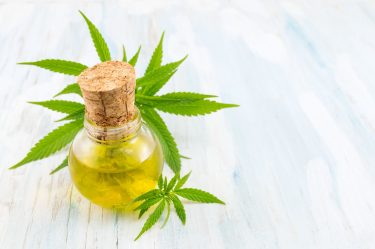
DOWNLOAD ENTIRE ARTICLE (with images and endnotes)
In this guide, our goal is to provide current and evidence-based information on marijuana and related substances in a succinct and easily accessible format. It is meant to provide a tool for those who wish to combat the flood of misinformation surrounding marijuana and to be an able assistant in, what can often be, a highly emotional debate.
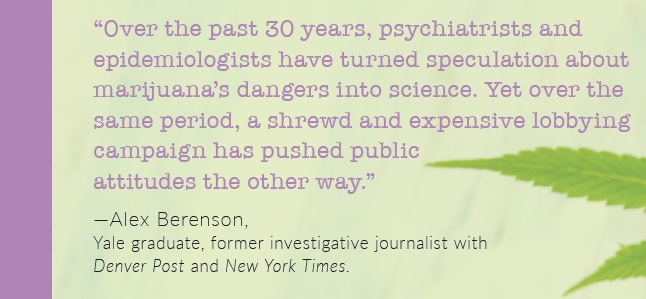
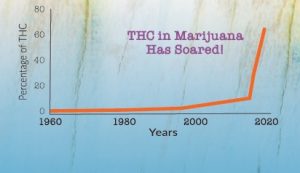 The pot smoked today is a very different drug than that smoked by preceding generations. In the 1960s and 1970s, THC content was around 2 percent. According to researchers at the University of Mississippi, the average THC content of illicit marijuana seized by the Drug Enforcement Administration (DEA) increased from 4 percent in 1995 to 12 percent in 2014. A 2015 study found legal marijuana in Colorado with THC content up to 30 percent. And 2018 testimony reveals THC concentrations as high as 65 percent in Washington State. (See graphic below.)
The pot smoked today is a very different drug than that smoked by preceding generations. In the 1960s and 1970s, THC content was around 2 percent. According to researchers at the University of Mississippi, the average THC content of illicit marijuana seized by the Drug Enforcement Administration (DEA) increased from 4 percent in 1995 to 12 percent in 2014. A 2015 study found legal marijuana in Colorado with THC content up to 30 percent. And 2018 testimony reveals THC concentrations as high as 65 percent in Washington State. (See graphic below.)
We’re dealing with a drug that has been modified to be far more potent than it was in the past. Because of that, it is presenting unprecedented problems. States that have legalized recreational use of marijuana are serving as unfortunate testing grounds and revealing frightening physical, psychological and social effects, especially with more frequent use and at higher-than-ever THC levels.

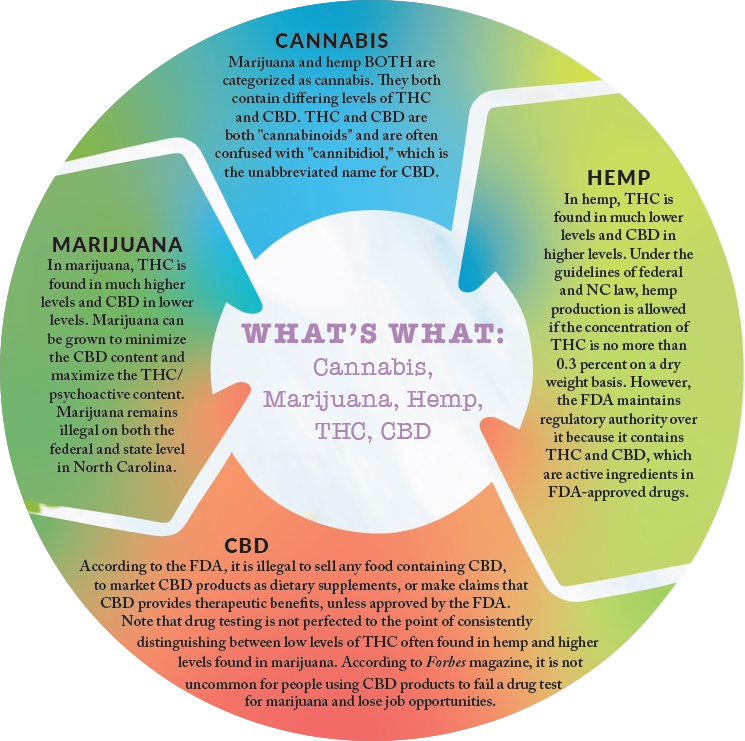
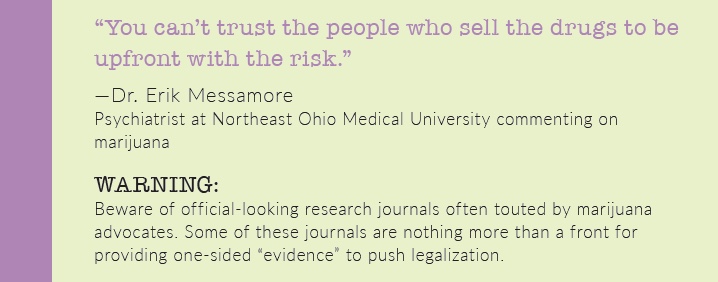
Emergency Room visits have skyrocketed in Denver since marijuana was legalized in Colorado in 2014. A March 2019 research study published in Annals of Internal Medicine shows a three-fold increase. “Marijuana-infused foods and candies, called edibles, also led to trouble. Patients came to the ER with symptoms such as repeated vomiting, racing hearts and psychotic episodes.” Three deaths have also been reported. Nine out of ten cases were Colorado residents, not out-of-state visitors experimenting with the drug, as some have suggested.
“When users had acute toxic reactions to old [lower THC] cannabis and came into the emergency room, it looked much like a panic attack. Unpleasant, to be sure, but the person had not lost touch with reality as in a psychotic reaction. In the age of new [higher THC] cannabis, the risk for acute psychotic reactions is much higher—we can see that in E.R. data both in the U.S. and Europe.”
—Keith Humphreys, Section Director for Mental Health Policy in the Department of Psychiatry and Behavioral Sciences at Stanford University

A European study just released in March 2019 in the preeminent psychiatry journal The Lancet Psychiatry found an even more alarming link: “People who smoked marijuana on a daily basis were three times more likely to be diagnosed with psychosis compared with people who never used the drug. For those who used high-potency marijuana daily, the risk jumped to nearly five times.”
In addition, a National Academy of Sciences report found:
Not only is today’s marijuana much more potent, it is often consumed in ways that increase THC intake. And since THC is slow-acting, users often accidentally ingest dangerous levels, a fact that has led to a jump in emergency room visits in Colorado, where marijuana is legal for recreational use (see page 6).
THC can be extracted from marijuana and made into oil concentrates. These can be added to joints (cannabis cigarettes), or put into edibles—cookies, brightly colored gummy bears and lollipops, brownies, rice krispie treats, and candy bars—which can be consumed in much higher volumes, much more easily and quickly. Popping a handful of THC-laced gummy bears can be far more toxic than smoking marijuana.
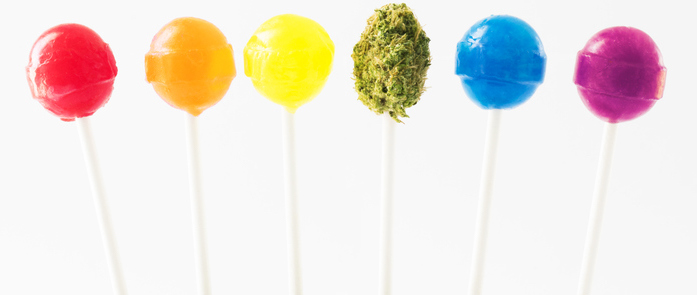
Lollipops in the colors of the rainbow, with a green marijuana bud on a lollipop stick in the middle.
The ability to ingest THC in the form of junk food is creating difficulties for the enforcement of drug laws. Unlike alcohol intoxication, there is not yet a quick test to check for use of marijuana, even for those driving under the influence. Children can be eating THC-laced treats around parents, teachers and other authorities without arousing suspicion. In addition, drug-sniffing dogs may have trouble distinguishing between the non-psychoactive CBD oil and products that contain THC.
— CNBC, 2019: “Legal Hemp, Pot’s Look-Alike, Creates Confusion For Police”
Teens who become weekly marijuana users by age 18 have a 37 percent higher chance of depression as adults. Researchers in Australia found that, among teens in Australia and New Zealand, those who became daily cannabis users before age 17 were seven times as likely to commit suicide, eight times as likely to use other drugs in their 20s, and 60 percent less likely to finish high school. More research is needed to consider pre-existing conditions and the effects of marijuana combined with alcohol.
Brain development during adolescence can be harmed by frequent cannabis use, and cognitive functions can be permanently reduced. […] Cannabis use in adolescence has also been associated with increased risk of psychosis in adulthood.”
—The Lancet Psychiatry, 2014
“Colorado now holds the dubious distinction of leading the country in first-time drug use. And the rate of monthly marijuana use among 18-to-25-year-olds in states with legal weed is nearly three times as much as states that haven’t legalized it.”
—”National Survey of Drug Use and Health” from the U.S Department of Health and Human Services
Although the American Medical Association maintains its opposition to legalization of marijuana by state legislatures, the organization supports increased research. Medical research continues on the use of chemicals derived from cannabis for prescription medications. However, at the time of this writing, the FDA has approved only one CBD-based medication, which is used to treat severe childhood epilepsy. There are two FDA-approved drugs containing a synthetic chemical similar to THC and used for treatment of nausea caused by chemotherapy and to increase appetite in patients with extreme weight loss caused by AIDS. The United Kingdom, Canada, and several European countries have approved a mouth spray containing THC and CBD for treatment of muscle control problems caused by multiple sclerosis, but it isn’t FDA-approved.
Research in the U.S. proceeds in states where laws permit it. According to their website, FDA.gov, “the FDA supports researchers who conduct adequate and well-controlled clinical trials which may lead to the development of safe and effective marijuana products to treat medical conditions.” The FDA website suggests there is data that seems to point to a drop in opioid abuse in states where marijuana is legalized, but emphasizes that there is no research to back this up at this point. And there are promising signs regarding treatments for cancer. Initial findings show “marijuana extracts may help kill certain cancer cells and reduce the size of others” when used in combination with radiation.
Meanwhile, research continues on claims that cannabis is useful in treating “anxiety, pain, arthritis, drug cravings, convulsions, and inflammation, […] epilepsy (the only ailment with the FDA stamp of approval), PTSD, fibromyalgia, endometriosis, Parkinson’s, and M.S.”
However, the FDA prohibits the marketing of cannabis products, such as CBD and THC, for therapeutic and medical uses unless approved by the FDA, because they “have not been evaluated as to whether they work, what the proper dosage may be if they do work, how they could interact with other drugs, or whether they have dangerous side effects or other safety concerns.”
A 2017 National Academy of Sciences report issues a strong caution that “unlike other substances whose use may confer risk, such as alcohol or tobacco, no accepted standards for the safe use or appropriate doses are available to help guide individuals as they make choices regarding the issues of if, when, where, and how to use cannabis safely and, in regard to therapeutic uses, effectively.”
The American Medical Association website has issued a statement that the AMA “believes that scientifically valid and well-controlled clinical trials conducted under federal investigational new drug applications are necessary to assess the safety and effectiveness of all new drugs, including potential cannabis products for medical use.” However, the statement goes on to say that the AMA “believes that cannabis for medicinal use should not be legalized through the state legislative, ballot initiative, or referendum process.”
Marijuana is still classified as a Schedule 1 controlled substance by the U.S. Drug Enforcement Administration (DEA). The DEA has twice denied petitions to reschedule marijuana “because it does not meet the criteria for currently accepted medical use in treatment in the United States, there is a lack of accepted safety for its use under medical supervision, and it has a high potential for abuse.”

Marijuana advocates have effectively framed the issue of legalized marijuana as a battle against “Big Pharma” and a “big bad” government that wants to deny relief for those suffering. They have been highly effective in branding pot as a miracle drug with lifesaving properties and no negative side effects—largely ignoring evidence and cries for caution from major medical associations and scientists.
By some counts, they appear to be running an effective public relations race, even if evidence is not on their side. According to the 2018 General Social Survey, conducted by the University of Chicago, “Support for legal marijuana hit 61 percent in 2018, up from 57 percent two years ago.” This support appears to cut across all age groups and political parties. “The 2018 poll is the first in which a majority of Republicans support legalizing marijuana—54 percent, up from 45 percent in 2016.”
Those who have dared to question the marijuana talking points have often been stunned by the backlash. Alex Berenson, award-winning author and investigative reporter, has written an expose and even a book on the dangers of marijuana abuse. According to an article in The Christian Institute, “the married […] father-of-two received death threats on social media, while other activists called his home to threaten his children. […] He said that some were threatening to give cannabis or cocaine to his children.”
“The Marijuana Business Factbook is projecting marijuana sales to soar to nearly $22 billion by 2022. […] There aren’t a tremendous number of industries with growth projections like that, which is why entrepreneurs and big-business leaders are rushing to find their place in the cannabis ecosystem,” most notably beer companies. “Corona brewer Constellation Brands made massive waves by investing $3.8 billion into Canadian marijuana grower Canopy Growth Corp. And according to The Wall Street Journal, Heineken and Molson Coors Brewing Company are close behind, having announced development deals for cannabis-infused drinks.”
—Green/Entrepreneur, Dec 2018: “Big Business Is Cashing In On The Cannabis-Fueled Green Rush”
—Alex Berenson, Yale graduate, former investigative journalist with Denver Post and New York Times.
In this Guide, we have done our best to provide accurate information on both sides of this critical health issue. Regarding negative evidence about marijuana use, John Stonestreet, president of the Colson Center for Christian Worldview says, “critics will respond, ‘That’s correlation, not causation.’ […] But as I heard [Journalist Alex] Berenson say just last week in Denver, of course it’s correlation and not causation. The only way to prove causation would be to ask half a sample group to experiment with something that may harm them. That’s not ethically possible. By the way, all the studies that made us believe that cigarette smoking causes lung cancer were correlated studies too, but that was enough to convince us all.”
No matter what the potential payoff might be, North Carolina should not be an early adopter in the marijuana arena—especially in regard to non-prescription medical and recreational use. Research on medical applications should continue and even be accelerated. However, the potential costs to the physical, psychological and social health of our citizens are too high and the evidence of potential harms is too great to proceed at this time.